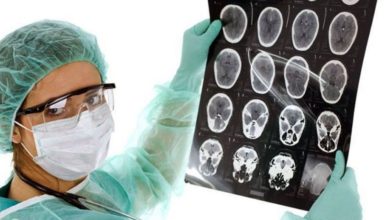Brain tumor removal
The content of the article
When a patient is diagnosed with a brain tumor (benign or malignant), the specialist’s priority is to remove the brain tumor.
Basically, surgery to remove a tumor in the head includes several stages of treatment, which include surgery, radiation therapy and chemotherapy. Depending on the characteristics of the tumor, all treatment methods can be combined to achieve the desired result. Basically, specialists resort to brain surgery for tumors.
Types of brain tumors
It is customary to distinguish several main tumors that develop in the human brain:
- Brain stem gliomas Tumors are localized in the canal that connects the brain and spinal cord. Such neoplasms are very different from normal cells and tend to grow very quickly. If the glioma has spread far along the connecting canal, then its treatment becomes very complicated. In order not to harm healthy brain tissue, it is customary to diagnose glioma without using a biopsy;
- Astrocytic. These tumors occur in or around the pineal gland (an organ that helps control the cycle of day and night).
- Ependymal. They are mainly localized in the ventricles of the brain, which protect the back and brain from mechanical damage. Such neoplasms can be of the first, second and third stages. In the first two cases, removal of a brain tumor is possible with a favorable prognosis;
- Medulloblastoma. They are neoplasms of the fourth stage and affect the lower part of the brain. It is mainly diagnosed in children and young people aged 20 to 40 years. This type can easily spread to the spinal cord through the cerebrospinal fluid;
- Meningial. They occur in the meninges, as well as the thin layers of tissue that protect the brain and spinal cord. Meningeal tumors can be stages 1, 2, or 3. The first stage is diagnosed most often and mainly in females. They are distinguished by their benign nature and slow development. As for the disease of the second and third stages, such neoplasms grow very quickly, as a result of which they can easily affect not only the brain, but also the spinal cord. They differ in their malignant nature, with stage three tumors most often diagnosed in men.
- Germinogenic. They arise from germ cells, which are responsible for the formation of eggs and sperm. These cells can spread to other organs and form tumors there. They can be either benign or malignant. In the brain, they are most often localized in the pineal gland, but can very quickly spread to the spinal cord.
Stages
The cancer process is usually described using stages, but there is no standard system for brain tumors. A primary tumor in the brain can affect the central nervous system and very rarely spreads to other parts of the body, that is, it does not metastasize. Before starting to remove the tumor, the consequences of which depend on the characteristics of the tumor, a specialist needs to establish an accurate diagnosis.
These tumors can be of any degree of malignancy:
- stage (piloid astrocytoma) – characterized by slow growth and rare spread to healthy tissue. Most often diagnosed in children and young people. Generally respond well to treatment;
- stage (diffuse astrocytoma) - characterized by slow growth, but unlike the first stage, they can quickly spread to healthy neighboring tissues. In the worst case, they become malignant. Mostly diagnosed in young people;
- stage ( anaplastic astrocytoma ) – characterized by a malignant nature, while such a formation grows rapidly and spreads to adjacent healthy tissue. Mostly diagnosed in people over 40 years of age;
- stage (glioblastoma) is a malignant tumor characterized by rapid development and spread to healthy tissue. Mostly diagnosed in people between 45 and 70 years old.
How to remove a tumor
When diagnosing a disease such as a brain tumor, surgery may consist of separate treatments, such as surgery and radiation therapy, or all at once. Combination treatment is used if surgery did not bring the desired result and the tumor was only partially removed.
The specialist takes a small part of a tissue sample of cancer cells and conducts a microscopic examination, which allows, based on the information received, to establish an accurate diagnosis and prescribe the necessary treatment. An important factor in this case is to avoid a threat to the patient’s life, as well as damage to healthy brain tissue.
If an operation to destroy cancer cells completely eliminates the tumor, then the specialist tries to do this. If the tumor has managed to spread to important parts of the brain, which, if removed unsuccessfully, can lead to impairment of neurological functions (paralysis, speech impairment), then the specialist tries to remove as many of the cancer cells as possible, and then sends the patient for radiation and chemotherapy, which allows to destroy the remaining ones cells.
Forecast
There is not always a chance for a complete recovery after removal of a tumor in the head. The prognosis after surgery depends on many factors that are individual for each patient. Treatment and prognosis after surgery depend on the type of disease, its location, rate of development, damage to important centers of the brain, etc.
As medical practice shows, the majority of benign neoplasms, which grow slowly and do not affect healthy tissue, can be cured without consequences.
How is the operation performed?
An operation to remove cancer cells, the consequences of which depend on the behavior of the tumor and the result of treatment, is generally performed under general anesthesia. If the tumor is localized near very important centers of the brain, then the patient may be conscious during the operation (craniotomy). After the operation begins and the skull is opened, the patient can be temporarily brought into consciousness, which helps specialists determine the amount of tumor tissue that can be removed without serious consequences for the patient. The patient is asked to read something, say something, or simply name words. This helps in the future to avoid speech disorders after surgery.
The consequences after surgery are directly related to the size of the tumor, as well as its location.
An important role here is played by the vessels in the head, which were involved in the development of the tumor. If the tumor is small in size and grows very slowly, then there is every chance of a successful operation without consequences for the health and life of the patient. The risk can increase significantly if we are talking about removing a large tumor. The use of modern treatment methods, as well as the use of unique methods of tumor removal, gives the effect that after surgery to remove a brain tumor, the consequences are practically not observed, but again, all this depends on the characteristics of the neoplasm itself in the brain.
Modern methods of treatment
- Intraoperative neuronavigation
This is a unique imaging method that allows you to design a more precise direction of the surgical instrument during the operation to destroy cancer cells. Using MRI , CT and ultrasound, the operated area is displayed on a screen in three dimensions. This allows specialists not only to more accurately study the structure of the patient’s brain, but also to develop the optimal route to the tumor for its complete or maximum partial removal. This method allows you to significantly save time during surgery, since the doctor sees the exact location of the tumor. The image can be updated if necessary. To do this, a repeat CT scan is performed during the operation itself.
- Intraoperative monitoring
During surgery to remove cancer cells, electrophysiological monitoring of the most important functions of the patient's nervous system is performed. This allows you to anticipate possible damage before the operation begins. Thanks to this method, the specialist receives complete information about exactly how the operated area works, which allows the operation to be carried out as carefully as possible and preserve the integrity of important organ structures.
Surgery
It is advisable to perform surgery to remove a brain tumor if there is a clear boundary between healthy and diseased cells. There are several types of surgical intervention:
- Complete removal;
- Partial removal;
- Two-step removal;
- Palliative surgery (it allows you to alleviate the patient’s serious condition).
Each method listed has a different level of risk, so recovery after surgery to remove a brain tumor can take a long time in some cases.
It is worth noting that complications cannot be ruled out after surgery:
- Damage to healthy tissues, nerve fibers, etc.;
- Infectious infection;
- Edema;
- Rapid relapse, which is caused by only partial removal of the tumor;
- Metastasis of cancer cells to other parts of the brain.
Rehabilitation after surgery
Rehabilitation after surgery removal includes several contraindications that are strictly prohibited:
- Abuse bad habits;
- Travel by air for 3 months after surgery;
- Engage in active sports with a high risk of mechanical damage;
- Visit baths and saunas;
- Go jogging (in this case it is better to walk at a brisk pace, which eliminates heavy shock-absorbing loads and strengthens the cardiovascular system);
- Visit sanatorium-resort boarding houses (depending on the climate);
- Use healing mud;
- Take vitamins, especially group B (in this case, you need to consult with your doctor, who will help you create the right diet and tell you what you can eat after surgery).
A very pressing question that interests many patients is how long does the operation to remove a neoplasm in the goloevum last? It will not be possible to answer this question accurately, since everything depends on the characteristics of the tumor, its size and location. Of course, if it is freely accessible, is not large in size, and there is a clear boundary between the affected and healthy tissues, the specialist will be able to perform the operation very quickly. It’s a completely different matter if the tumor is localized near an important part. In this case, much more time, effort and concentration of a specialist is required.
Rehabilitation
The postoperative period implies the maximum possible restoration of all lost organ functions, as well as the patient’s return to normal working life without the interference of others. Even if it is not possible to completely restore all functions, rehabilitation aims to adapt the patient to the limitations that have arisen and make his life as easy as possible. It may often be necessary to restore speech after surgery, especially if the localization was near the area responsible for speech, and the cancer cells managed to affect it a little.
As practice shows, the rehabilitation period takes about 3-4 months. Its main goals are:
- Adaptation of the patient to a new lifestyle;
- Restoration of all lost functions;
- Learning essential skills for life.
Individual approach
The rehabilitation process for each patient will be individual. For this purpose, short-term and long-term goals are established. The first are tasks that must be completed in a short period of time. This includes the ability to sit up in bed independently. After the assigned goal has been achieved, the second, third, and so on begin. Setting and achieving short-term goals allows specialists to assess the dynamics in the patient’s condition.
A brain tumor is a very serious disease, but the rehabilitation period is no less difficult, which requires a lot of not only physical, but also mental strength. That is why it is not necessary to neglect the services of a psychologist in this case; moreover, his professional help is often needed not by the patient himself, but by his close circle.
Massage
The patient may be prescribed massage as physiotherapy. It is used if the patient develops paresis of the limbs. Thanks to a professional approach, massage can improve blood supply to muscles, relieve swelling, increase sensitivity in the limbs, and improve neuromuscular conduction.
In addition to massage, physical therapy provides a good effect. It is applied to the patient both before and after surgery. In the preoperative period, this procedure is prescribed only if the patient’s general condition allows it. It increases muscle tone and also trains the functioning of the heart and lungs.
Physiotherapy
As for the postoperative period, physical therapy is used to restore all lost functions, form new conditioned reflex connections, and also help fight vestibular disorders.
After stabilizing the patient’s general condition, he can be transferred to a vertical position, which allows focusing on lost movements and their restoration. If there are no contraindications, then the patient can be transferred to a more active mode, which will allow him to quickly restore walking. The recovery method also includes the use of additional items: weights, balls, etc.
It is very important during the rehabilitation period to pay the patient’s attention to all improvements, even minimal ones. This will contribute to his normal emotional state (often, after such an operation, patients are diagnosed with a greater tendency to depression), as well as an incentive to quickly restore all lost abilities.
Please rate the article:






Thank you for the article